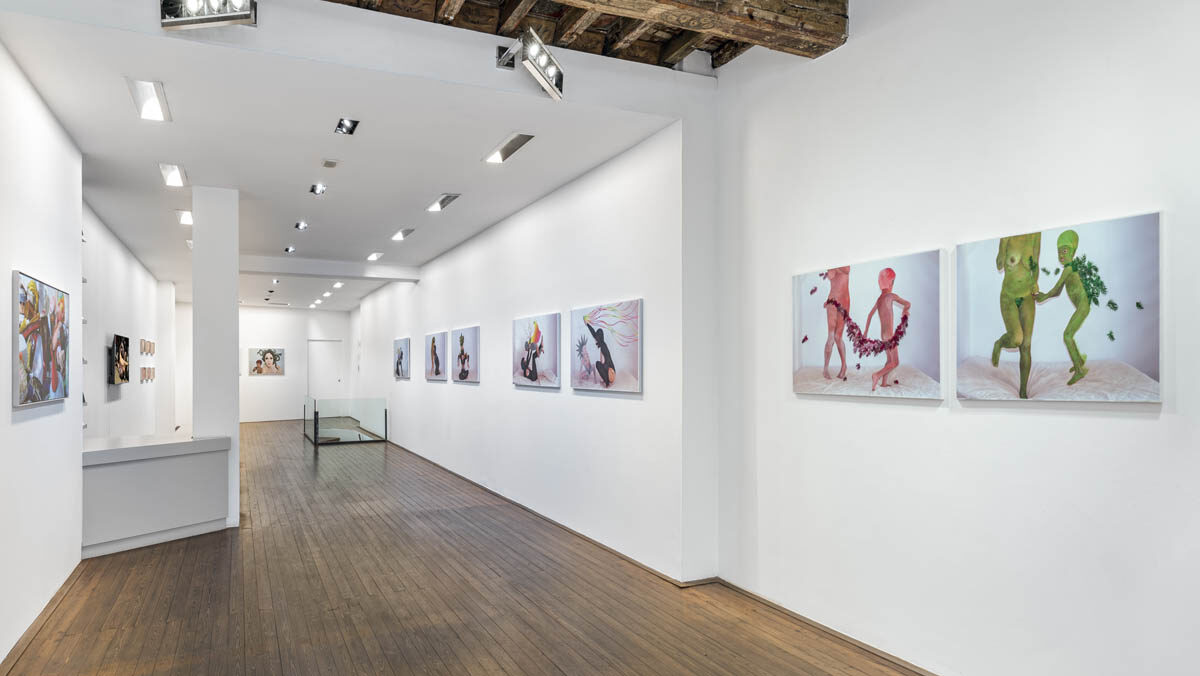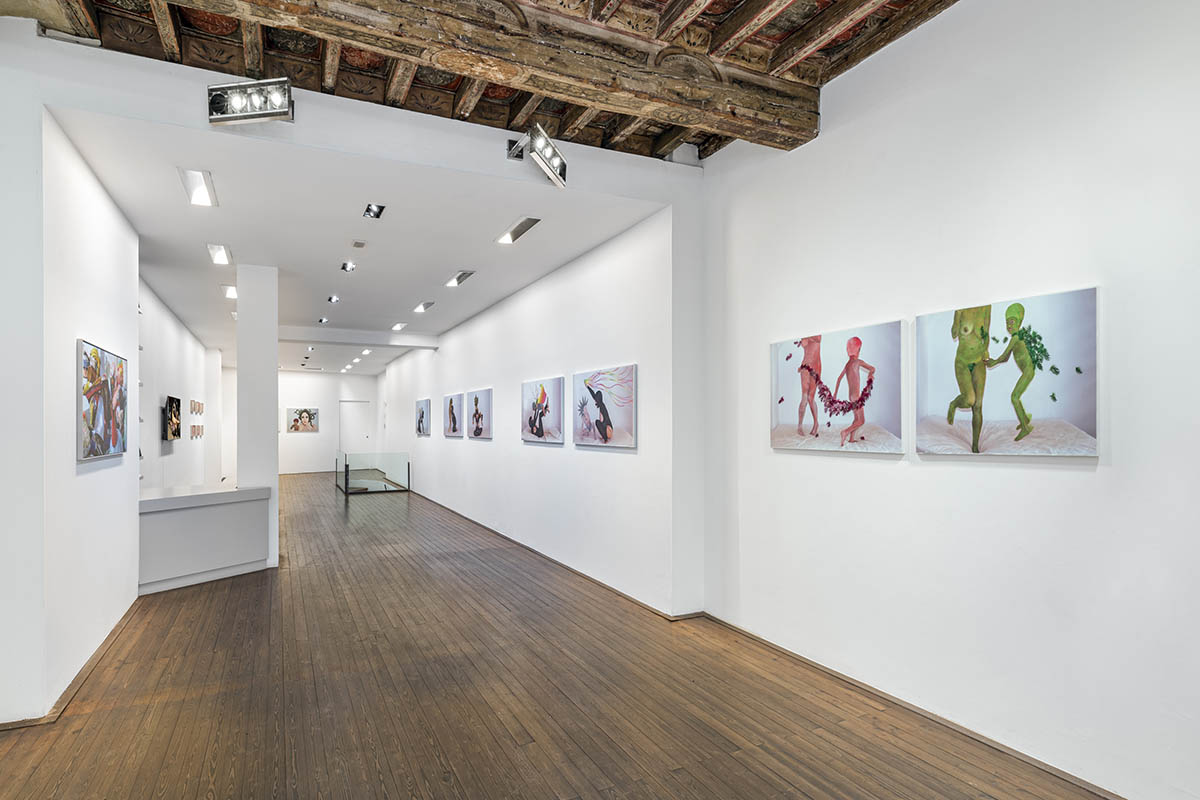
Gruni’s works also address the tension and conflicts in valorizing women’s roles in Italy, Brazil, and around the world. She uses her body to promote the feminist cause and engage in choral dialogue with other performers, writers, and directors, creating collective works that touch raw nerves. This approach has enabled her to attain great heights in her production as an artist, creating ‘total works’ of contemporary art. I spoke with her during “Motherboard” solo show, part of the Florence Art Show, at Galleria Il Ponte in Florence.
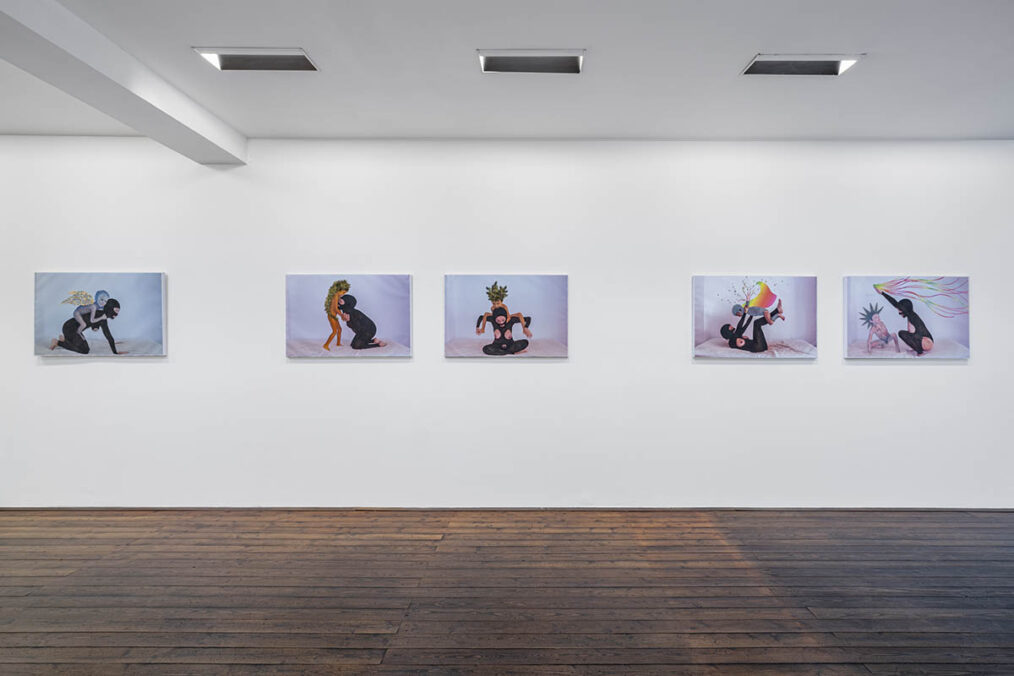
Exhibition view. Photo: Ela Bialkowska | OKNO studio 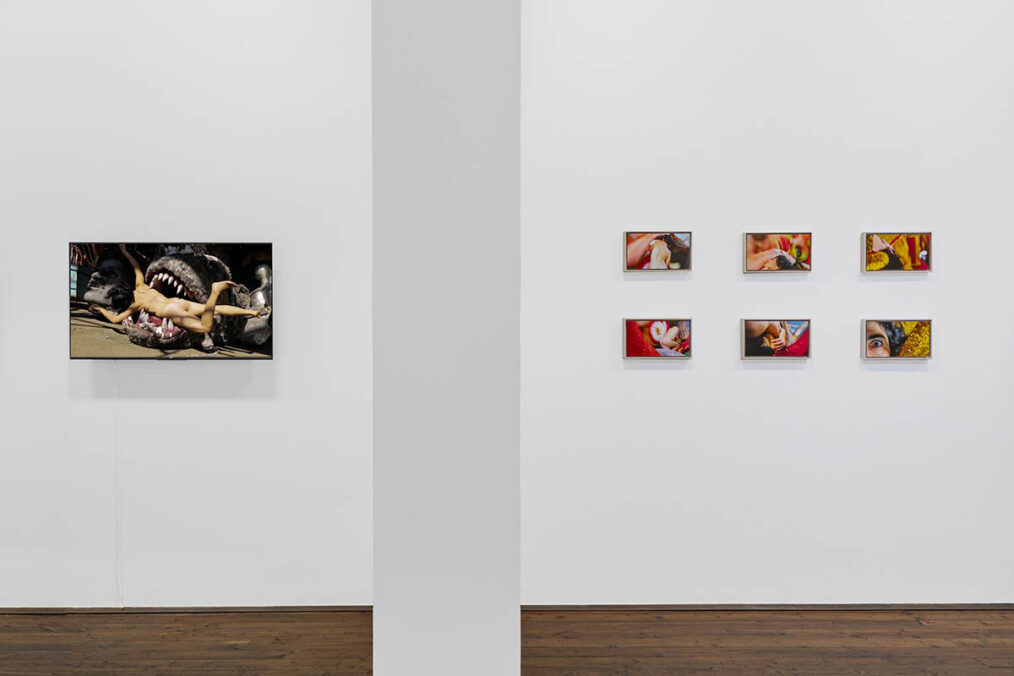
Exhibition view. Photo: Ela Bialkowska | OKNO studio
How did your upbringing influence your art-making? What informs it today?
My artistic research (experimentation) is characterized by a strong interest in the human condition, and this is inevitably linked to place. At the beginning of my career, as was natural, I started off researching and experimenting with the stories of my own country, specifically those of the region of Tuscany; that is, digging into my own roots. In 2010, I moved to California and then to Brazil, and I have been a sort of nomad, partly by choice and partly by necessity, and that is absolutely reflected in my own work. I was fascinated as I noticed how many symbols that are part of a local reality often end up linking us to a more global one. I deeply believe in comparing different cultures and in the possibility of a common development.
My artistic exploration arises from the need to exorcise the fear of what is different. Starting from inner reflection that tends towards a collective dimension, my body is the catalyst to reach out to others through various kinds of interaction. Performance is the staple of my projects. However, the actions are not conceived as a spectacle but rather as a constantly evolving process. The different media used in the performances – photography, drawing, sculpture, video, and installation – allow me to run the gamut and overlap various means of expression. I go in for handmade and crafted works that connect me to a popular dimension. Anthropological and sociocultural research and exploration have become increasingly important aspects for me. Other people’s participation in my work is also fundamental. I welcome others into the project and invite them to interact, sometimes in the lead role, and other times as partners to create a temporary collective. Working with one’s own ego is very complex. But despite its difficulties, it is precisely what I want to do: experience/experiment with life through art.
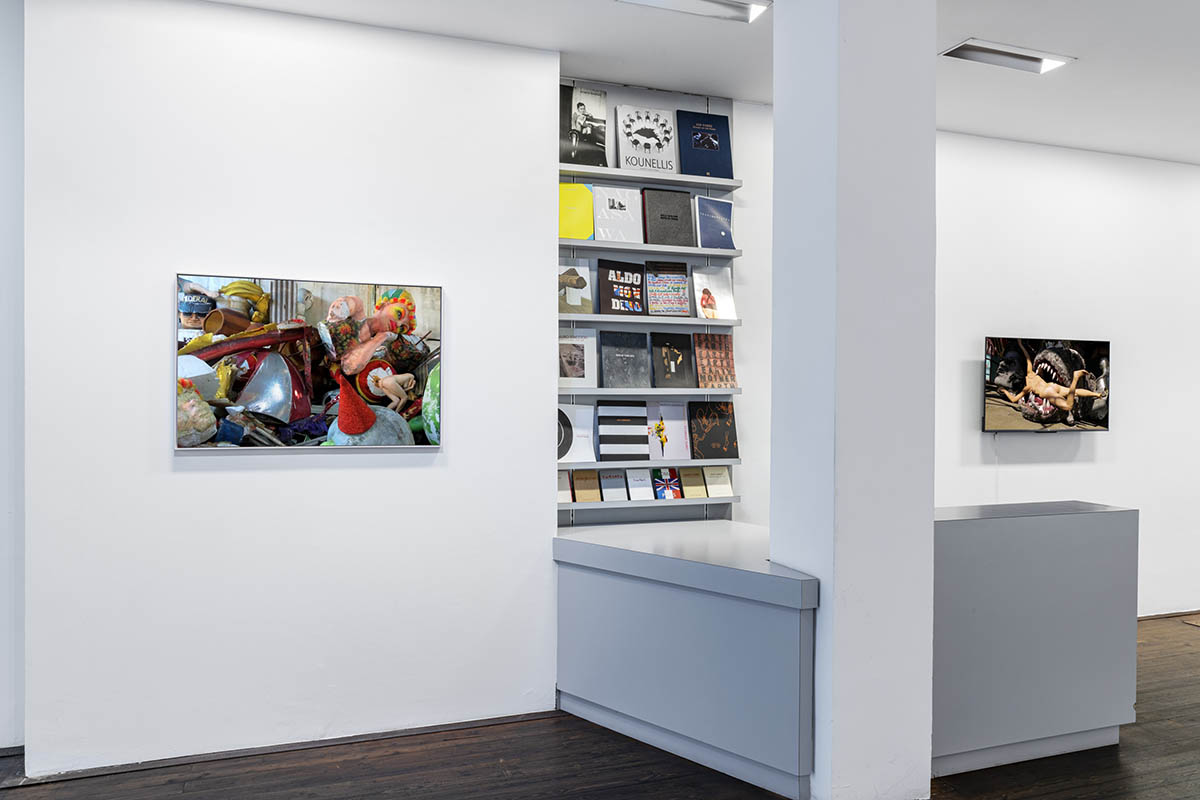
Your exhibition is divided into three different projects Segunda pele, Fromoso, and Motherboard. Please tell us about it.
The exhibition consists of three different projects, presented by way of video installations, video performances, lambda prints on aluminum, and mixed techniques on photographic print: Segunda pele, Fromoso, and Motherboard.
How did you install it at Galleria Il Ponte, for Florence Art Week?
The left side of the first floor of the space is dedicated to Fromoso: a photo shot backstage, the video-performance and six frames from the video. The right side and the gallery’s back wall are dedicated to Motherboard: ten images realized with mixed techniques on photographic print. The space in front of the stairs and the underground space are dedicated to Segunda pele: fifteen small drawings and the video installation.
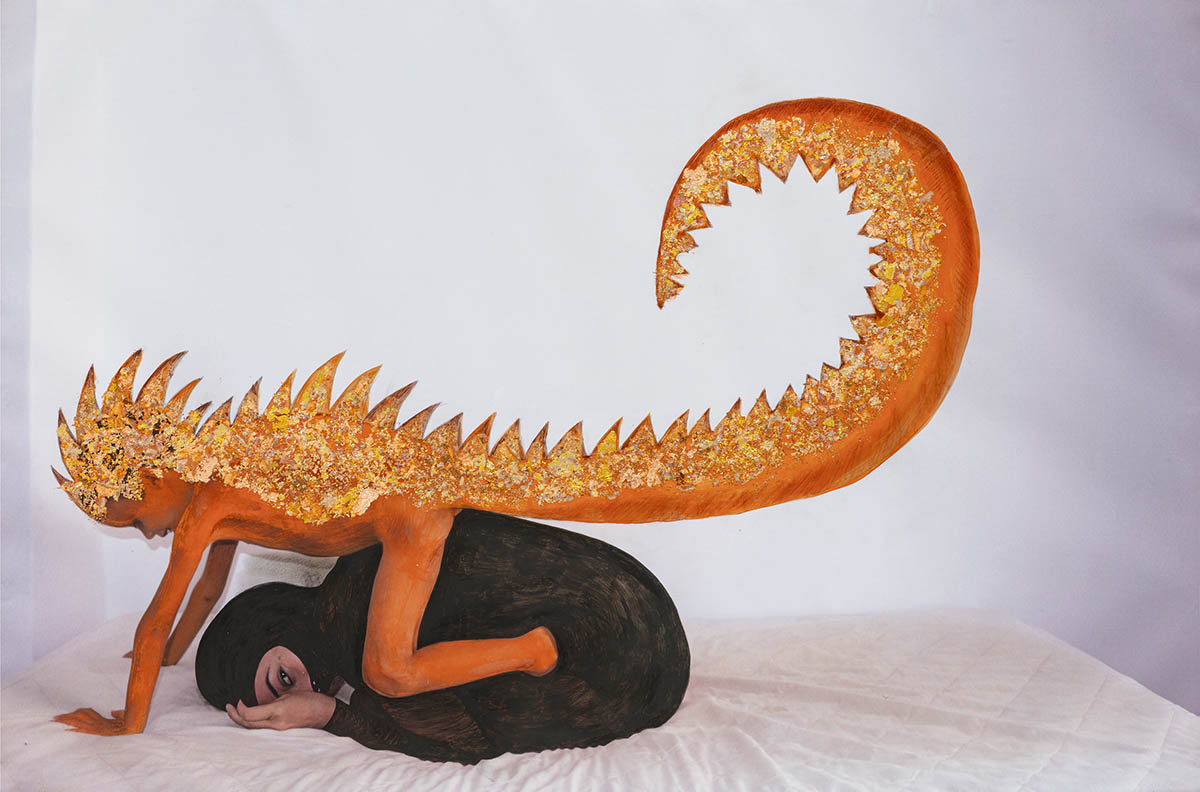
How do these three projects enter into a conversation?
The projects Motherboard, Fromoso, Segunda pele, offer insights on the concepts of motherhood, anthropophagia and hybridity, respectively. All these concepts are linked with “transformation”.
What is important to you about the visual experiences you create? What drives you?
I’m basically driven by anger. I make art to provide order to my “chaos”.
What drives you in the Motherboard project?
The “motherboard” is responsible for the transmission and correct timing of hundreds of different signals, all at high frequency and sensitive to disturbances between processors, expansion boards, and external peripherals. Therefore, for a performative and reliable circuit, it is vital that the motherboard be well-made. Motherboard is a project on motherhood. It is a series of photographic images caught with the automatic shutter release while playing with my son. The “painted mask” applied to them leads to the continual transformation of the characters and, at times, to role reversals between mother and son. Irony and drama blend together as well as symbolic elements borrowed from collective memory: antiquity, mythology, pop culture, digital technology, and social themes.
Choose a piece in your show and tell us the story behind it: what was on your mind when you started it? Please describe your process from conception to end.
The Segunda pele (Second Skin) project came about from the need to expand my individual artistic experimentation towards a collective dimension. I have been designing and producing works based on the interaction between body and object, performance and sculpture, for several years now – performative objects conceived as extensions of the body, sculptures that can be worn or inhabited, using recycled materials. These “second skins” become a sort of filter between my body and the outside world, helping me to tackle unknown territories and solve difficulties. The need to reflect on contemporary society inevitably raises topics such as memory, identity, and fear… and the aim has become to transform this dialogue into performative and political action. So, I decided to launch this same proposal to other artists, through a course called “Second Skin: Hybrid, Memory, and Recycling” which I delivered at the EAV school of Visual Art (Escola Artes Visuais) in Parque Lage, Rio de Janeiro, for two years between 2017 and 2019. The meetings took place in a climate of coexistence and dialogue, spontaneously bringing together young artists and activists who use their bodies as a language. Creating contemporary experiences in the era of communication. Mutating identities that need to cry out against oppression and command respect in an extremely violent and transphobic city, in a colonized country that continues to be racist, and in a globalized society that is becoming unhealthier every day. Since they are moving images, we had to resort to audiovisual means, prompting the desire to partner with filmmaker Alexis Zelensky in order to produce videos drawn from this work. The set for the performers’ actions is the forest of Parque Lage (an urban forest in Rio de Janeiro), a place throbbing with life, also fighting to survive in the urban context of the city. Every performance is an authored work springing from individual impulses, but the mosaic of all these actions becomes a collective work. Together, subjective differences meet, coming out stronger and united to fight against the “liquid fear” endemic in contemporary society, a fear that seeks to divide and control us. Despite the difficulties, there is still hope that those who believe in art, and in culture in general, can become a vehicle of resistance.
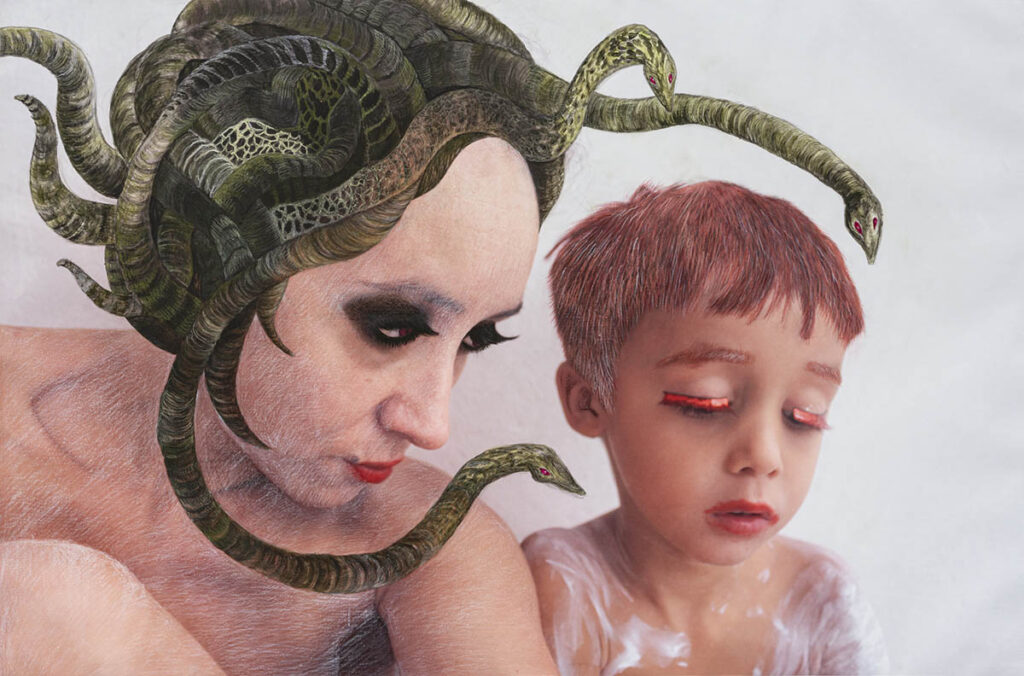
What is your current obsession?
Investigating the concept of “fear of difference” in contemporary society.
9- Can you introduce us to your Segunda pele publication?
Zoè Gruni, Segunda pele is a book edited, by Metilene Edizioni, in 2023 by Metilene in three languages, Italian, English, and Portuguese. The project developed during my experience in Brazil, which came about from my need to exorcise the fear of difference. In this research, the body becomes the catalyst capable of relating to others and the main filter between the human being and the world. After graduating from the Academy of Fine Arts in Florence, I moved to California and then to Brazil, where I lived for many years, devoting my research to the study of social contexts and local cultures. Starting from a reflection on contemporary society, I evoke stories of resistance linked to indigenous peoples and the African culture brought by the slaves while dealing with themes such as religious syncretism, decolonization of thought, gender issues, LBGTQIA+ communities, minority struggles in the favelas, and much more. Back in Italy, I found myself writing these memoirs as a reflection on the power and fragility of human beings. I also wanted to put across this complexity by making a series of drawings in which the people become fairytale-like characters.
Exhibition: Zoè Gruni. Motherboard
Duration: 28 September – 17 November 2023 at Galleria il Ponte Firenze
Zoè Gruni – www.zoegruni.net
Camilla Boemio is an internationally published author, curator, and member of the AICA (International Arts Critics) and IKT (International) based in Rome. In 2013, Boemio was the associate curator of PORTABLE NATION: Disappearance as Work in Progress – Approaches to Ecological Romanticism, the Maldives Pavilion at the 55th International Art Exhibition La Biennale di Venezia. In 2016, Boemio curated Diminished Capacity, the First Nigerian Pavilion at 16th International Architecture Exhibition La Biennale di Venezia. Boemio’s recent curatorial projects include her role as associate curator at Pera + Flora + Fauna. The Story of Indigenousness and The Ownership of History, an official collateral event at the 59th International Art Exhibition La Biennale di Venezia, 2022, which is commissioned by PORT and the state government of Perak, Malaysia; the same year she was co-curator of Bruno Lisi: Segno Aperto at MLAC and Museo dell’Arte Classica, two museums part of Polo Museale Sapienza in Roma. Invitations to speak include the Tate Liverpool, MUSE Science Museum, Pistoia Musei and the Cambridge Festival 2021 at Crassh, in the UK. www.camillaboemio.com




